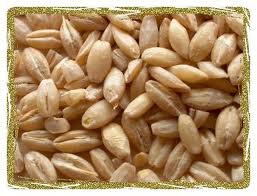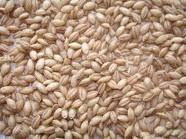Barley and wheat are two of the most ancient crops and there are archeological records of barley being used in the Stone Age Lake dwellings in Switzerland, and around the Sea of Galilee 8,500 years ago. Barley originated in Ethiopia and South East Asia, where it has been cultivated for over 10,000 years. The first known recipe containing barley goes back to Babylonia and 2,800 BC. A barley water drink has been prepared throughout the ages, and one of the traditional drinks in the Indian sub-continent is sattu, which is very refreshing and cooling on hot summer days and nights.
 The ancient Greeks had the goddess Demeter who was the goddess of agriculture and barley figured in the religious rites of her cult. Barley was an offering to the goddess and made into a drink during the celebration of the Eleusian mysteries. In Roman mythology her equivalent was Ceres. There was a cult of the Corn-Mother (corn being used as a generic term for grain crops) in Europe in ancient times. Barley was made into bread, sometimes along with rye, and was a staple throughout the Middle Ages.
The ancient Greeks had the goddess Demeter who was the goddess of agriculture and barley figured in the religious rites of her cult. Barley was an offering to the goddess and made into a drink during the celebration of the Eleusian mysteries. In Roman mythology her equivalent was Ceres. There was a cult of the Corn-Mother (corn being used as a generic term for grain crops) in Europe in ancient times. Barley was made into bread, sometimes along with rye, and was a staple throughout the Middle Ages. The ancient Greeks and Romans gave their athletes barley in their diets to give them stamina and the ancient Hindus also offered barley to their gods and goddesses. The Romans fed their gladiators on barley and they became known as “hordearii” or “eaters of barley”; so this is where the botanical name comes from.
 |
| Hulled barley |
Barley was not only used to make bread, but was fermented to make alcohol, both beer and whiskey, and in Britain there is still a potent bottled drink called “Barley Wine.”
 This grain when whole or just hulled has many health benefits, containing as it does a large amount of selenium, and other minerals which include potassium, copper, manganese, magnesium, iron, phosphorous and zinc. As for vitamins it has some of the B-complex ones along with vitamin E. It also contains lignans which are also found in flax and pumpkin seeds, coffee, tea, red wine and nuts. It has antioxidant properties and is helpful to reduce the risk of heart disease and some cancers. It is good if you are prone to constipation because of the fibre content and this can also help in cases of diarrhoea. There is a long-term study of barley and its potential health benefits underway and preliminary results appear to confirm that a diet which includes barley can help stabilize blood sugar levels, although this has not yet been proved conclusively. It may also offer some protection against certain cancers. However the study still has a long way to go before results can be determined. The study centres on the beta-glucans that are contained in barley and is an effort to determine the effects of these not only on blood glucose levels but also on insulin. It is hoped that the study will help those suffering with Type II diabetes.
This grain when whole or just hulled has many health benefits, containing as it does a large amount of selenium, and other minerals which include potassium, copper, manganese, magnesium, iron, phosphorous and zinc. As for vitamins it has some of the B-complex ones along with vitamin E. It also contains lignans which are also found in flax and pumpkin seeds, coffee, tea, red wine and nuts. It has antioxidant properties and is helpful to reduce the risk of heart disease and some cancers. It is good if you are prone to constipation because of the fibre content and this can also help in cases of diarrhoea. There is a long-term study of barley and its potential health benefits underway and preliminary results appear to confirm that a diet which includes barley can help stabilize blood sugar levels, although this has not yet been proved conclusively. It may also offer some protection against certain cancers. However the study still has a long way to go before results can be determined. The study centres on the beta-glucans that are contained in barley and is an effort to determine the effects of these not only on blood glucose levels but also on insulin. It is hoped that the study will help those suffering with Type II diabetes. |
| Pearl barley |
The best barley to use is straight barley which had not been processed and this needs to be soaked overnight before using (see sattu), as does hulled barley which is the next best type to gain the maximum health benefits. Barley can be added to stews and sauces and has a nutty flavour and should be chewy, like al dente pasta. Try the recipe below. You can use it with chicken or beef or lamb for cold winter’s days, and because of the selenium it will give you a feeling of well-being.
Pearl barley, pot or scotch barley and barley flakes have undergone a rigorous processing and do not have the same health benefits as the types of barley mentioned above.
Like oats you can grind barely to a powder and mix with a little water to use as a face mask. You should apply the paste and leaves it to dry on your skin, before rinsing it off with tepid water, then splashing cold water on your face for the best effects. It is a good cleanser and will rejuvenate your skin, especially in winter when it may be damaged by the cold.
Barley is very versatile and certainly has health benefits, unless of course you cannot take gluten.
HEARTY BARLEY STEW
100 gr barley (soaked overnight, drained and rinsed)
250 gr beef, cubed
100 gr beans of your choice,
(chickpeas/garbanzos are good, soaked overnight)
2 large onions, sliced
4 cloves garlic, finely chopped
4-6 carrots sliced
1 stick celery (halved)
2 turnips, cubed
1 small swede, cubed
handful of fresh parsley shredded
1 tsp dried oregano or 2 tbsp fresh
2 bay leaves, torn but whole
1 wineglass red wine
1 tbsp flour
olive oil for frying
Method
Heat the oil in a large pan and add the beef and seal well on all sides, then add the onions and garlic and fry for a few minutes.
Add the carrots and fry for a further few minutes.
Add the flour and stir well then add 2 pints water, slowly and bring to the boil.
Add the rest of the ingredients and bring back to the boil, adding more water if necessary.
Keep an eye on the water level and cook for two hours or until all the ingredients are tender. Do not add salt until the last half an hour as this will prevent the barley and beans softening.
Remove from the heat and remove the celery stalk. Adjust the seasoning and serve with fresh crusty bread.
This has Taste and is a Treat.




